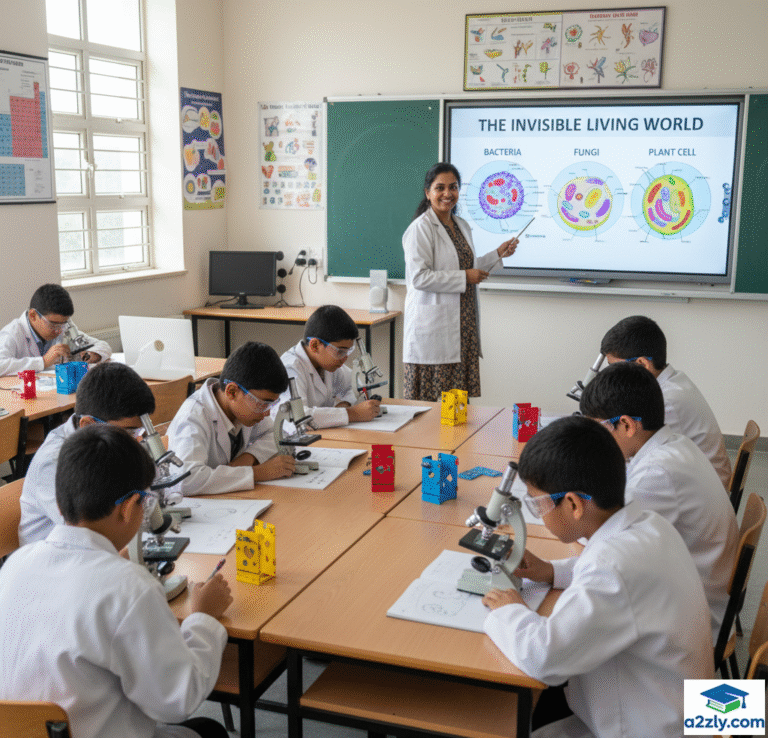🧭 Chapter Overview
Have you ever imagined what the world looks like beyond what our eyes can see?
There exists a whole universe of tiny living organisms, invisible to the naked eye, yet essential to life on Earth. These microscopic beings — called microbes or microorganisms — help decompose waste, make food, recycle nutrients, and even keep our bodies healthy.
This chapter, “The Invisible Living World: Beyond Our Naked Eye”, takes you on a journey from the discovery of the microscope to the amazing world of cells and microorganisms, showing how science has revealed what was once hidden.
Table of Contents
🎯 Learning Objectives (NEP 2025 Competency Table)
| Competency | Learning Outcome | NEP Skill |
|---|---|---|
| Conceptual Understanding | Explain the discovery of cells & microorganisms | Conceptual Clarity |
| Analytical Thinking | Compare plant and animal cells | Scientific Reasoning |
| Inquiry & Exploration | Use foldscope/microscope to observe microbes | Practical Inquiry |
| Application | Relate microbes to health, environment & food | Life Application |
| Ethical Awareness | Understand microbes’ role in sustainability | Environmental Responsibility |
🔬 2.1 The Discovery of the Invisible World
🔍 From Lenses to Microscopes
Humans have always been curious about the world around them.
Centuries ago, people discovered that curved glass lenses could make small things appear larger. Over time, these lenses were refined and used to create the microscope — a tool that changed the way we look at life.
Robert Hooke (1665):
- Invented a simple microscope.
- Observed thin slices of cork.
- Saw honeycomb-like structures and named them cells — the building blocks of life.
Antonie van Leeuwenhoek (1670s):
- Improved lenses and observed living microorganisms for the first time.
- Described bacteria, blood cells, and protozoa.
- Known as the Father of Microbiology.
🧠 Fun Fact: Hooke’s Micrographia was the first book showing the microscopic world through detailed drawings.
🧫 2.2 What Is a Cell?
Every living being — from a small ant to a giant elephant — is made up of cells.
A cell is the smallest structural and functional unit of life.
Just as bricks build a wall, cells build an organism.
🧪 Activity 2.1 – Observing an Onion Cell
Aim: To observe cells using a microscope.
Steps:
- Take an onion bulb and peel off its thin transparent layer.
- Stain it with safranin (red dye).
- Mount it on a glass slide with glycerin.
- Observe under a microscope.
Observation:
You’ll see rectangular cells with thick walls arranged compactly.
Each cell shows:
- Cell wall – provides shape and strength.
- Cytoplasm – jelly-like fluid inside.
- Nucleus – round, central structure controlling cell activities.
🧪 Activity 2.2 – Observing Human Cheek Cells
Aim: To observe an animal cell.
Steps:
- Scrape your inner cheek gently with a toothpick.
- Stain the sample with methylene blue.
- Observe under a microscope.
Observation:
You’ll see irregularly shaped animal cells with a cell membrane, cytoplasm, and a nucleus, but no cell wall.
🌿 Differences Between Plant and Animal Cells
| Feature | Plant Cell | Animal Cell |
|---|---|---|
| Outer Covering | Cell wall + Cell membrane | Cell membrane only |
| Shape | Regular (rectangular) | Irregular (round/oval) |
| Chloroplast | Present | Absent |
| Vacuole | Large central vacuole | Small or none |
| Function | Photosynthesis, Storage | Movement, Response |
🧠 Remember: The cell wall and chloroplast make plant cells unique.
🧠 2.3 Variation in Shape & Function of Cells
Not all cells look alike! Their shape suits their function.
| Cell Type | Shape | Function |
|---|---|---|
| Muscle cell | Spindle-shaped | Contraction & movement |
| Nerve cell (Neuron) | Long & branched | Transmit messages |
| Cheek cell | Flat & polygonal | Protective covering |
| Root hair cell | Elongated | Absorb water from soil |
| Guard cell | Kidney-shaped | Control gas exchange in plants |
💡 The shape of a cell always supports its function — this is called “structure-function relationship.”
🌱 2.4 From Cells to Organisms
Every organism is organized in levels of increasing complexity:
Cell → Tissue → Organ → Organ System → Organism
Example (in humans):
- Muscle cells → form muscle tissue
- Tissues → form stomach (organ)
- Organs → form digestive system
- All systems together → form a human body
🧬 The life of complex organisms begins with a single fertilized cell — the egg cell.
🦠 2.5 The World of Microorganisms
Tiny living organisms that cannot be seen with the naked eye are called microorganisms or microbes.
They’re found everywhere — in water, air, soil, and even inside our bodies!
🧫 Types of Microorganisms
| Type | Example | Key Feature |
|---|---|---|
| Bacteria | Lactobacillus, Rhizobium | Unicellular, no true nucleus |
| Protozoa | Amoeba, Paramecium | Single-celled, animal-like |
| Fungi | Yeast, Bread mould | Can be uni- or multicellular |
| Algae | Chlorella, Spirogyra | Contain chlorophyll |
| Viruses | Influenza virus, HIV | Multiply only inside host cells |
🌊 Activity 2.3 – Observing Pond Water
- Take a drop of pond water.
- Observe under a foldscope or microscope.
- You’ll see tiny moving organisms — Amoeba, Paramecium, and algae — all part of the invisible world!
💧 These organisms recycle nutrients and help maintain ecological balance.
🌍 2.6 The Role of Microorganisms in Nature
Microbes are small but mighty! They play essential roles in:
🌾 1️⃣ Cleaning the Environment
Bacteria and fungi decompose dead plants and animals → forming manure and enriching the soil.
This process is called decomposition.
Example:
Fruit peels in compost → decomposed by microbes → turns into natural fertilizer.
🔥 2️⃣ Producing Biogas
Certain bacteria break down organic waste to produce methane (CH₄), a clean energy source.
Used for cooking, lighting, and even running engines!
🍞 3️⃣ Making Food
- Yeast makes bread and cakes soft and fluffy.
- Lactobacillus turns milk into curd and batter into idli/dosa mix.
- Fermentation = Conversion of sugar into alcohol/acids by microbes.
🌿 4️⃣ Helping Plants Grow
Rhizobium bacteria in root nodules of pulses fix nitrogen, enriching soil fertility naturally.
🧬 5️⃣ Producing Oxygen
Microalgae like Spirulina and Chlorella release oxygen and are also used as food supplements — called superfoods!
🌍 Our Scientific Heritage
Ancient Indian texts like the Atharvaveda mention “Krimi” — tiny visible and invisible living beings.
They recognized both beneficial and harmful microbes long before modern microscopes existed!
🪶 Vrikshayurveda (Ancient Indian Plant Science) also described how decomposers enrich soil fertility naturally.
🧫 2.7 Microbes in Our Daily Life
| Use | Microorganism | Product |
|---|---|---|
| Bread & Cakes | Yeast | Soft & fluffy dough |
| Curd & Cheese | Lactobacillus | Lactic acid fermentation |
| Dosa & Idli Batter | Bacteria | Fermentation |
| Biofertilizer | Rhizobium | Fixes nitrogen |
| Medicine | Penicillium | Antibiotic (Penicillin) |
🌿 Microorganisms are nature’s silent helpers!
🧠 2.8 The Cell: Basic Unit of Life
All living beings — plants, animals, and microbes — are made of cells.
A cell can perform all functions of life such as respiration, growth, and reproduction.
🧬 Unicellular Organisms
- Single-celled (e.g., Amoeba, Bacteria).
- Perform all life functions within one cell.
🌿 Multicellular Organisms
- Made of many cells (e.g., Humans, Trees).
- Specialized cells perform specific roles (like digestion or respiration).
🧩 Key Cell Parts
| Structure | Function |
|---|---|
| Cell Membrane | Controls what enters/leaves cell |
| Cytoplasm | Site for chemical reactions |
| Nucleus | Controls all activities |
| Cell Wall (plants) | Provides rigidity |
| Chloroplast (plants) | Photosynthesis |
| Vacuole | Storage and shape maintenance |
⚠️ 2.9 Harmful Microorganisms
While most microbes are helpful, some cause diseases in humans, animals, and plants.
These are called pathogens.
Examples:
- Bacteria: Typhoid, Cholera
- Virus: Influenza, COVID-19
- Fungus: Ringworm
- Protozoa: Malaria
🧠 HOTS (Higher Order Thinking Skills)
- How does yeast make dough rise?
- Why is Rhizobium called a farmer’s friend?
- Why is Spirulina called a superfood?
- What would happen if decomposers vanished?
- Can viruses be considered living organisms? Why or why not?
⚙️ NEP COMPETENCY FRAMEWORK
| Domain | NEP Skill | Real-Life Application |
|---|---|---|
| Conceptual | Understand cell and microbes | Observe with foldscope |
| Analytical | Compare microbe types | Chart or table work |
| Practical | Experimentation | Curd & yeast activity |
| Creative | Model creation | 3D cell or microscope |
| Ethical | Sustainability | Composting project |
💡 Memory Booster Box
🔹 All living beings = made of cells
🔹 Microorganisms = seen only with microscopes
🔹 Yeast → Bread, Rhizobium → Soil fertility, Lactobacillus → Curd
🔹 Microbes decompose waste → manure
🔹 Microalgae = oxygen producers & biofuel sources
⚠️ Exam Alert Box
📍 Define: Cell, Microorganisms, Fermentation.
📍 Differentiate: Plant vs Animal cells.
📍 Explain: Role of Rhizobium & Lactobacillus.
📍 Activity-based: Observing onion peel & cheek cells.
📍 HOTS: What would happen without microbes?
📘 Quick Recap
✅ Cells are the basic units of life.
✅ Microorganisms are everywhere — air, soil, water, and our bodies.
✅ Many microbes are beneficial — decomposers, fermenters, oxygen producers.
✅ Some microbes cause diseases, but others sustain life.
✅ Microscopes opened the invisible world for human discovery.
🔗 INTERNAL & EXTERNAL LINKS
Internal Links (A2ZLY):
- Chapter 1 – Exploring the Investigative World of Science Notes 2025
- Chapter 3 – Diseases and Microbes Class 8 Notes 2025
- NEP 2025 Smart Notes Hub | A2ZLY
External Links:

